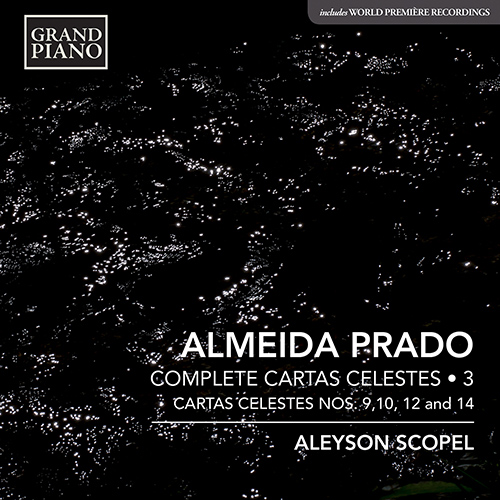REZENDE DE ALMEIDA PRADO, J.A.: Cartas Celestes, Vol. 3 - Nos. 9, 10, 12, 14 (Scopel)
Almeida Prado’s vast cycle of Cartas Celestes (Celestial Charts) depicts the celestial bodies visible in the Brazilian night sky during the four seasons of the year. As the cycle evolves so does Almeida Prado’s sound world and colour palette, reaching a highly transcendent and poetic view of the universe with an ever-evolving harmonic language that includes the composer’s own invented “transtonality”. The composer himself described Aleyson Scopel’s performances on Volume 1 [GP709] as “straight from heaven!”
Tracklist

Brazilian pianist Aleyson Scopel has performed worldwide in solo, chamber and concerto settings. A recipient of the Nelson Freire and Magda Tagliaferro awards, he has also won numerous prizes in international competitions such as the William Kapell, Villa-Lobos, Corpus Christi, Kingsville and Southern Highland International Piano Competitions.
Besides the core masterpieces of the piano repertoire, he has a keen interest in contemporary music that reflects the modern idiom of the instrument. His performance of the first set of Cartas Celestes by Almeida Prado was thus received by the composer: ’It came straight from heaven! Meteor Showers, radiant constellations, glowing nebulae and a transcendental vitality marked the genial interpretation of this colossal pianist.’ Prado would later dedicate to Scopel the 15th set of the series. Aleyson Scopel played his first piano chords at the age of 14. Shortly after that he graduated with distinction in performance and academic honours from the New England Conservatory of Music, in Boston.
During his years at the conservatory he studied with Patricia Zander and was also awarded the Blüthner prize. He then furthered his studies in Brazil with Celia Ottoni and Myrian Dauelsberg.
For more information, visit www.aleysonscopel.com.

One of the most prolific composers to emerge from Brazil, José Antônio Rezende de Almeida Prado began as a cultivator of nationalism, studying with Camargo Guarnieri, but as a pupil of Boulanger and Messiaen in Paris was compelled to look for other means of self-expression, attaining a level of aesthetic freedom which encompassed atonalism, post-serialism, extended and free tonalism. Among his most important achievements, referred to by him as an “incredible adventure”, are his 18 Cartas Celestes (Celestial Charts), a set of works depicting the sky and constellations, in which he adopted a new harmonic language called “transtonality”. Of the 18 Cartas Celestes, 15 are written for solo piano, while the remaining three are scored two pianos and symphonic band (No. 7), for violin and orchestra (No. 8) and for piano, marimba and vibraphone (No. 11).































